Dental Care and Procedures
At Town & Country Veterinary Care we believe that good oral health is the bedrock upon which good general health and longevity are built. That is why we place a strong emphasis on good dental healthcare for your pet. During every Annual Wellness Examination we specifically perform an oral examination to assess the condition of the teeth and gums. We emphasize frequent dental prophylactic cleanings and home oral health care. Brushing, rinses, dental chews, and dental health foods are a few tools available to maintain your pets smile. Our Dental Program at Town and Country consists of procedures such as routine dental cleanings, dental extractions and oral surgery. We believe that good oral health leads to a healthy pet!
Did you know?...
 Dental disease is the number 1 disease affecting dogs and cats in the U.S.
Dental disease is the number 1 disease affecting dogs and cats in the U.S.
 80% of dogs and 70% of cats show signs of dental disease by the age of 3.
80% of dogs and 70% of cats show signs of dental disease by the age of 3.
 If left untreated, dental disease can lead to bone loss, jaw fractures, swelling/draining sores on your pet’s face, a number of systemic complications such as diseases of the heart and other organs.
If left untreated, dental disease can lead to bone loss, jaw fractures, swelling/draining sores on your pet’s face, a number of systemic complications such as diseases of the heart and other organs.
Professional Exam & Cleaning Requirements
Testing & Procedures Recovery
SANOS Barrier Sealant Home Care
Professional Exam & Cleaning
Professional dental cleanings are important to the long-term health of our dogs and cats. At Town & Country, pets who undergo dental procedures receive a thorough oral exam, dental radiographs, ultrasonic scaling, polishing and fluoride treatment. All dental patients are anesthetized in order to perform these procedures.
During the dental exam, your veterinarian examines the teeth and overall condition of your pet’s mouth. They examine the surface structure of your pet’s teeth looking for evidence of surface abnormalities (such as enamel fractures, defects and discoloration), displacement of teeth, missing or extra teeth, and cavities. Inflammation and/or discoloration of the gums also indicate present problems. The vet uses a periodontal probe to measure for periodontal pockets around teeth and looks for evidence of conditions that may lie below the gum line that may require further investigation and treatment.




Dental radiographs allow us to examine root and bone health. Problems below the gum line can exist even when the surface of the mouth, gums and teeth appear normal. These xrays can provide evidence of abcesses, root resorbtion and even bone loss. 60% of periodontal disease found in dogs and cats is below the gum line.
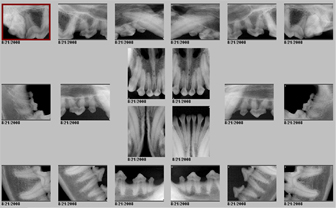
Testing & Procedures
In order to receive a thorough oral exam and cleaning, as well as for their own safety and comfort, dental patients are anesthetized for all dental procedures at TCVC. Because pets can mask serious conditions that could jeopardize their well-being under anesthesia, we require all patients scheduled for anesthetic procedures to undergo pre-anesthetic testing. This testing includes:
 Complete Blood Count (CBC) – Checks for elevated white blood cell count (which could be a sign of infection or inflammation), red blood cell count (which can indicate dehydration or anemia) and platelet count (which cab indicate a coagulation disorder).
Complete Blood Count (CBC) – Checks for elevated white blood cell count (which could be a sign of infection or inflammation), red blood cell count (which can indicate dehydration or anemia) and platelet count (which cab indicate a coagulation disorder).
 Coagulation Test (COAG) – Blood clotting test, to alert us to pets that may have a bleeding crisis.
Coagulation Test (COAG) – Blood clotting test, to alert us to pets that may have a bleeding crisis.
 Electrocardiogram (ECG) – Checks heart rhythm and heart’s electrical activity. We look for abnormalities such as arrhythmias and electrical conduction disturbances.
Electrocardiogram (ECG) – Checks heart rhythm and heart’s electrical activity. We look for abnormalities such as arrhythmias and electrical conduction disturbances.
 Chemistry Panel (Chem-6) – Checks for kidney parameters, liver enzymes, blood glucose level and total protein level.
Chemistry Panel (Chem-6) – Checks for kidney parameters, liver enzymes, blood glucose level and total protein level.
Our pre-anesthetic testing can be performed the day of and up to 2 weeks prior to the scheduled procedure. Should concerns about your pet’s health arise from this testing, the dental procedure may be postponed. Your veterinarian will then be able to discuss subsequent options with you.
Throughout anesthesia, a technician is dedicated to monitor your pet by observing heart rate, respiration, temperature, and IV fluid flow. During the procedure, your pet will receive antibiotics, anti-inflammatory and pain relief medication. We have found this helps pets recover moree quickly.
SANOS Barrier Sealant
Plaque can start to reattach to your pet’s teeth within hours after their professional cleaning. The SANOS sealant can help enhance your investment in your pet’s health.
SANOS Dental Barrier Sealant - SANOS Sealant is applied by your vet, directly after your pet’s cleaning. It serves as a barrier on your pet’s teeth, preventing the build-up of plaque and tartar at/below the gum line. It is especially effective to aid in protection of those “difficult to reach” areas. One application by your vet helps to protect your pet’s teeth for up to an additional 6 months!
The SANOS Sealant is not a standard element of our dental cleaning procedures. If you are interested having the SANOS Barrier Sealant applied to your pet's teeth, talk to our staff to learn more.
Requirements
We require dental patients to be current on their vaccinations and parasite testing according to Town & Country protocols prior to being checked-in to our facilities. Click here to learn more about our vaccination protocols. Click here to learn more about Town & Country parasite testing and prevention. If you have not already done so, please be sure to provide our Service Coordinators with your pet's complete medical and vaccination history.
If your pet is scheduled at our Bandera Rd. Hospital, we ask that patients be admitted the night before their scheduled procedure. This allows pets to get settled and for us to prepare them for their surgery. For our Northwest Clinic patients, please have them there before 9am. It is important not to feed them after 10pm the night before their procedure. Upon admission, your pet will be given a Capstar to help maintain flea control within our facility.
Recovery
It is important to provide pets with antibiotics to help them fight the oral bacteria that is broken up, inhaled and swallowed throughout their dental cleaning. And should extractions or periodontal surgery be necessary, there is an increased risk of additional infections at the surgical site. These antibiotics usually are prescribed over a 7 day period, and may be administered at home, either prior to or as a follow-up to the dental cleaning, depending upon your doctor’s recommendations.
After their dental cleaning, your pet may be groggy from the effects of the anesthesia, which may last up to 24 hours. We recommend feeding your pet just a small amount of their regular food, 5-6 hours after the cleaning. They can resume standard feedings the following day, although they may not eat normally until the second day home. If your pet not is eating normally by their second day home, contact your veterinarian.
After a standard cleaning, you may see a little blood in your pet’s saliva. If this lasts more than 2 days, or becomes heavy, contact your veterinarian immediately.
Home Care
Home dental care is an important part of maintaining your pet’s well-being. It helps to prevent plaque and tartar build-up, and promotes healthy gums. This will minimize the severity of dental disease between dental cleanings thus reducing the risk of more extensive periodontal disease. There are several home treatment options with varying degrees of efficacy. Please consider all of them, and determine which is best for your family.
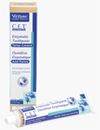 | HOME BRUSHING - This is the most effective home care. Brushing your pet’s teeth daily with a VOHC* (Veterinary Oral Health Council) approved toothpaste and a bristled toothbrush provides the best defense against plaque and dental decay. For the safety of your pet, do not use toothpaste sold for human use. |
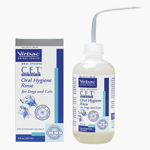 | ORAL HYGIENE RINSE - Splashed on your pet’s teeth daily or after each meal, the Oral Hygiene Rinse kills bacteria, providing effective plaque control and freshens breath. |
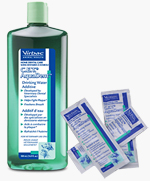 | AQUADENT DRINKING WATER ADDITIVE - Added to your pet’s drinking water, this product helps to maintain your pet’s oral hygiene and freshen breath every time they drink. Reduces plaque and tartar buildup by more than 50%. |
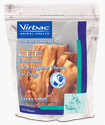 | C.E.T. DENTAL CHEWS - These treats for dogs and cats contain chlorhexadine which kills bacteria,as in the products listed above. These chews may be given to your pet daily. |
 | SCIENCE DIET t/d (dental diet) - Several pet food manufacturers offer dental diets for dogs and cats, such as Hill's Science Diet t/d. Dental diets are a crispier and larger kibble. The physical structure of the food disrupts the formation of plaque on the teeth. Although helpful in the attack against plaque, this is the least effective method of dental home care. |
When dental home care is begun at an early age, pets easily become accustomed to it. Older pets will learn to tolerate it little by little - just be patient! They may even learn to enjoy it!
Make your pet’s dental home care part of their usual routine. The time and attention you give will really pay off and your pet will love you for it!



